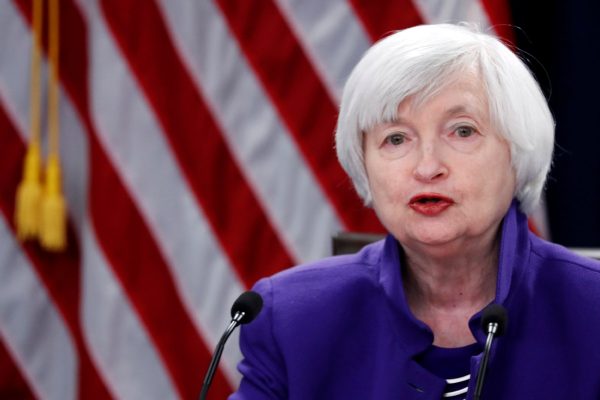
US outgoing Federal Reserve Chair Janet Yellen holds a news conference after a two-day Federal Open Market Committee (FOMC) meeting in Washington, US, Dec 13, 2017. [Photo/Agencies]
WASHINGTON – US Federal Reserve on Wednesday raised the benchmark interest rates for the third time this year and maintained the forecast of three more rate hikes in 2018, as the economy and job market continued solid growth.
“In view of realized and expected labor market conditions and inflation, the (Federal Open Market) Committee decided to raise the target range for the federal funds rate to 1.25 to 1.5 percent,” said the Fed in a statement after concluding two-day monetary policy meeting.
In December 2015, the central bank first raised the interest rates from nearly zero and hiked three more respectively in December 2016, March, and June this year. It also started to reduce its 4.5-trillion-US dollar balance sheet from October this year.
The decision to raise interest rates is based on the assessment that the job market will remain strong growth. The central bank adjusted the statement language about the job market, painting a rosy outlook.
“This change highlights that the committee expects the labor market to remain strong, with sustained job creation, ample opportunities for workers and rising wages,” Fed Chair Janet Yellen said on Wednesday at her last press conference before her four-year term ends early next year.
According to the quarterly economic projections released the same day, Fed officials expected the unemployment rate will maintain at 4.1 percent by the end of 2017, lower than September’s forecast of 4.3 percent. It will further drop to 3.9 percent in 2018.
She emphasized the risks of labor market overheating, saying that it would require the central bank to tighten monetary policy abruptly, jeopardizing economic expansion.
Fed officials also raised their forecast for economic outlook. According to their forecast, the U.S. economy will grow 2.5 percent both in 2017 and 2018, higher than their forecasts in September which projected a 2.4 percent growth for 2017 and 2.1 percent increase for 2018.
“Participants generally identified changes in tax policy as a factor supporting this modestly stronger outlook, although many noted that much uncertainty remains,” said Yellen.
During the conference, Yellen cautioned that the new forecasts shouldn’t be viewed as estimates of the impact of the tax policy and stressed the uncertainty about the impact.
Fed officials, including herself, widely believed that the tax policy would tend to provide only “modest” lift to GDP growth in the coming years, said Yellen.
On this expectation, Fed officials largely kept their forecasts for inflation outlook and the pace of future rate hikes unchanged.
They expected the inflation would grow 1.7 percent in 2017 and further strengthen to 1.9 percent in 2018, and still envisioned three more rate hikes in 2018, unchanged from their forecast in September.
The forecasts indicated that Fed officials saw no reason to accelerate the pace of future rate hikes, although the proposed tax cuts would modestly boost the growth.
Yellen recognized that the soft inflation was one of the risks the policymakers were facing. However, she said that Fed officials continued to believe that the factors which were holding down inflation this year were likely to prove transitory.
They continued to expect the inflation will go up to the central bank’s 2 percent target in the medium term, said Yellen.
In view of the rather low inflation reading, Yellen stressed that it’s appropriate for the central bank to tighten monetary policy gradually.
At the press conference, Yellen noted that her nominated successor, Jerome Powell, has been part of the consensus shaping the Fed’s gradual rate hike strategy.
Powell, now a Fed governor, was nominated by President Donald Trump in November to replace Yellen when her terms ends in February, 2018.
Investors and market watchers widely expected that Powell will maintain the continuity of the monetary policy at the central bank.


